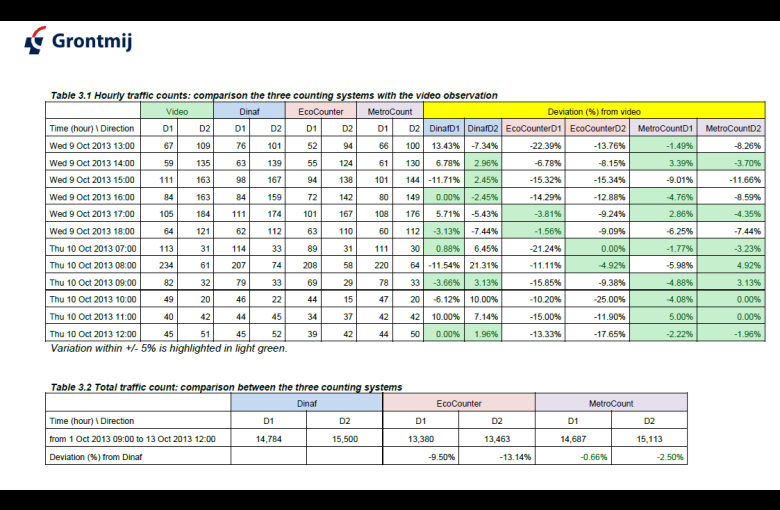Besides the Dinaf count tubes already present at the test location, two other counting systems were deployed for the tests:
- Our RidePod BP permanent piezoelectric system;
- EcoCounter: using an induction loop glued to the bicycle path.
Videos were taken at the test location on Wednesday, October 9, 2013 (afternoon) and Thursday, October 10, 2013 (morning). These videos establish the actual traffic passages (the ‘reality’) and can be used to evaluate and compare the three counting systems.
Results
Table 3.1 shows the hourly traffic counts registered by video and the three counting systems. The general implications are:
- Dinaf registered the highest number of bicycle passages. For some periods, the Dinaf count is even higher than reality (as established by video). This is attributed to possible ghost/double registrations in the Dinaf counts. Because the Dinaf data only contain hourly counts, it is impossible to investigate the deviations further.
- MetroCount registered slightly fewer passages than Dinaf, but the MetroCount results are more agreeable with reality than the Dinaf results are (looking at the magnitudes and variation of the hourly deviations). Further analysis of individual passages shows that when a group of bi-cycles passed the test location, MetroCount sometimes missed a bicycle.
- EcoCounter showed the biggest deviations from reality (average for the 12 hourly periods: 11.9%). The variation from period to period is also very large.
- For the 12 hourly periods, Dinaf has the smallest variation from reality (1.2%), and MetroCount is slightly bigger (4.5%). However, Dinaf's hourly deviations vary greatly from period to period, compared to MetroCount's.
Table 3.2 shows the total traffic counts by the three systems for a whole period of nearly two weeks (from 1 to 13 Oct 2013). The results here indicate that:
- The difference between the Dinaf count and the MetroCount count is relatively small (less than 2%). Here, the Dinaf count is slightly higher than the MetroCount count.
Conclusions
In terms of the total count, Dinaf shows the smallest deviation. However, MetroCount's hourly deviations are more stable than Dinaf's.
An advantage of MetroCount is that it uses piezoelectric strips, which can be buried beneath the road surface, instead of test tubes, which are laid above the road surface. This requires less maintenance and also causes no hindrance to the bicycle traffic.

Got a great MetroCount story? Share it with us and let the world know the great work you're doing in your community.

